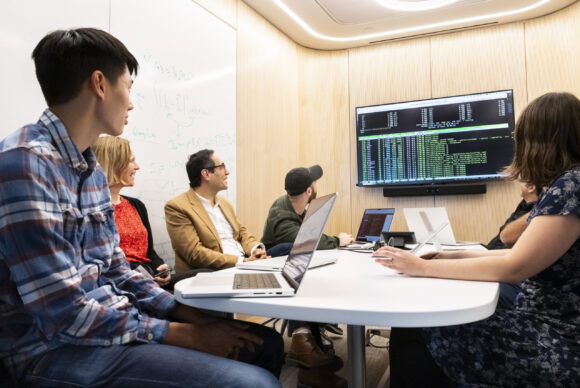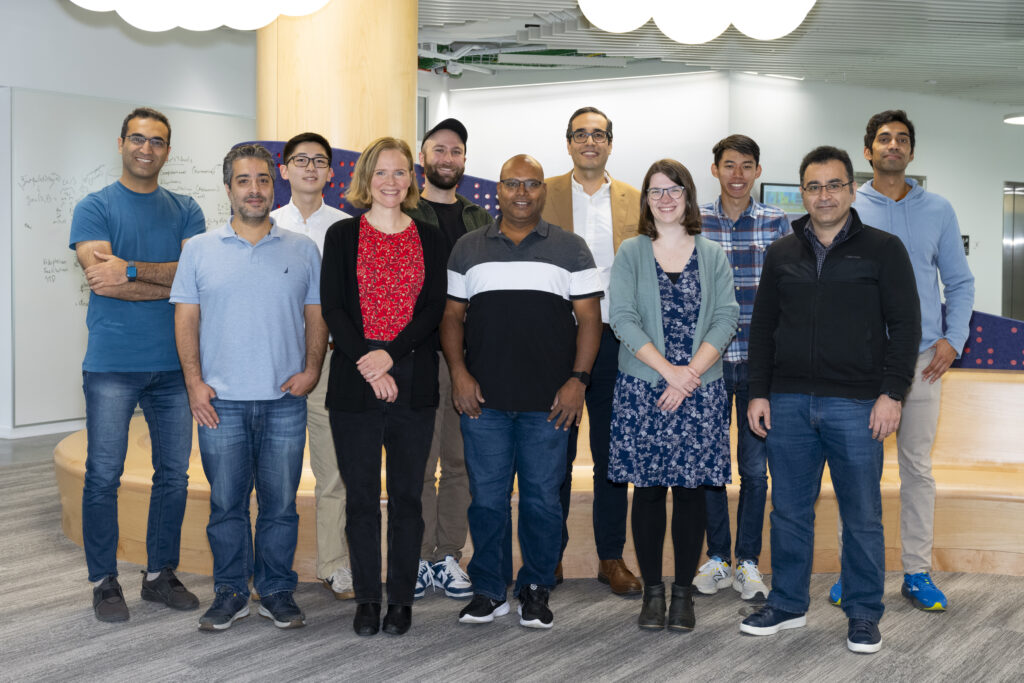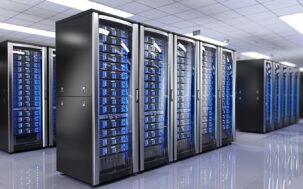Introducing the Kempner’s Research & Engineering Team

Members of the Kempner Institute's Research & Engineering team work with Kempner researchers to develop and implement large-scale computational projects central to AI, ML, and neuroscience. Above, R&E team members work together at the Kempner Institute.
Photo credit: Anna Olivella
If you are a part of the Kempner community, odds are that you’ve heard about the institute’s Research & Engineering (R&E) team, a full-stack team of industry-grade technical experts who support the work of Kempner researchers. But what exactly does the R&E team do and how does it fit into the larger picture of the Kempner and its research?
The R&E team collaborates with researchers as they develop and implement large-scale computational projects central to AI, ML, and neuroscience. Researchers innovating in the Kempner’s core research areas – artificial intelligence, machine learning (ML), and computational neuroscience – must integrate scientific creativity with hardware optimization, software engineering, and data architecture. No individual can be an expert in all these areas, which is where the R&E team comes in.
“This is a Formula One team,” says Elise Porter, Executive Director of the Kempner Institute, referring to the faculty researchers, students and R&E team members who collaborate to take a research project from ideation to implementation. “The faculty and researchers drive the car and set the race strategy, and the R&E team works to support them, innovating at every level to make the machine faster, more efficient and more reliable.”
With expertise in fields ranging from applied engineering to cutting-edge computational research, the R&E team enables scientists to make the most of the Kempner’s AI cluster, one of the fastest academic computing clusters in the world.
“We’ve made a capital investment in the hardware, but also a huge investment in the human support infrastructure through the R&E team,” says Porter. “And that’s one of the things that really sets the Kempner apart from other academic institutions doing this kind of work.”
An in-house tech consultancy
The caliber, breadth and depth of support that the Kempner R&E team provides is something that few academic researchers anywhere in the world are able to access. With the support of the R&E team, researchers can develop and test state-of-the-art models that require deep understanding of engineering topics as well as the scientific and mathematical underpinnings of ML and computational neuroscience.

Sarah Leinicke, Lead Technical Project Manager, explains that the R&E team has deep technical and research skills that allow the Kempner community “to develop and maintain a high-quality, robust, and adaptable technical infrastructure.” This, she notes, “ensures that researchers can reliably reproduce earlier work, develop it further, and share tools and methods across multiple projects.”
In a typical academic environment, scientific code is developed and maintained by the researchers themselves: often just a single research assistant, student or postdoc. This works well for exploratory, proof-of-concept research that is easy to perform on a personal computer. But the codebases associated with such projects tend to decay once that crucial lab member leaves. Code repositories may be infrequently maintained, so newcomers to a research group end up reinventing the wheel, or wasting time updating programs to work with the latest software packages. All too often, this leads to research that is not reproducible.
While academic researchers sometimes pay external consultants for professional-grade software development and maintenance, this comes with its own issues: the work of consultants is typically paid for by grants and is therefore project-specific, preventing researchers in the same department from sharing solutions.
At the Kempner, academic researchers work directly with members of the R&E team to fill gaps in their skillsets, or to collaborate on finding creative and elegant solutions to tough research, coding or engineering questions.
“The takeaway is that people with expertise in this hardware are hard to come by,” says Porter. “This type of skillset is fairly new, and many people with these skills find themselves in industry settings. Not many traditional academic environments have the bandwidth to hire a team like this.”
Sharing a repository of institutional knowledge
In addition to supporting researchers as they develop and implement large-scale computational projects central to AI, ML, and neuroscience, the R&E team also ensures the growth and continuity of the Kempner’s institutional knowledge and supports its commitment to open and reproducible science.
“Building and maintaining institutional knowledge is essential both for the growth of the institute, and also, importantly, for overall advancement in the field,” says Kempner Senior Director of AI/ML Research Engineering Max Shad. “The speed of innovation in this field is so much faster than in a traditional academic research field, and by harnessing and sharing findings in real time, we are able to bring those insights and tools to researchers around the world.”
The R&E team maintains the Kempner Institute’s public repositories, including GitHub and HuggingFace, to ensure the public availability of new ideas, code and data generated by Kempner researchers. This is an essential aspect of the Kempner’s mission, to make sure science emerging from the institute is publicly available and reproducible, so that it can benefit the larger research community.
In acting as a repository for institutional knowledge, the R&E team also plays a key role in allowing for cross-fertilization of ideas at the Kempner. By working with different research teams on a cross-section of projects, the team can bring insights from one project to bear on a totally different project, leveraging know-how that can advance research across the board.
In addition, the Kempner R&E team contributes to the institute’s body of institutional knowledge by undertaking their own research projects, allowing them to stay up-to-date on the latest methods and to pursue technical and scientific innovation. In this sense, the team borrows its approach from industry, thinking in terms of products in addition to projects, producing reproducible code and datasets shared publicly on GitHub and HuggingFace, honoring the institute’s commitment to open science, and contributing to advancement in the field.






